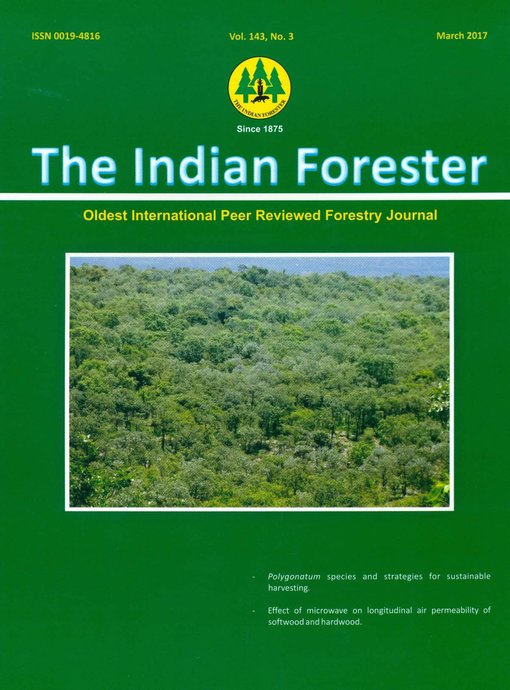Effect of Microwave on Longitudinal Air Permeability of Softwood and Hardwood
DOI:
https://doi.org/10.36808/if/2017/v143i3/113614Keywords:
Eucalyptus tereticornis, Longitudinal, Microwave, Pinus roxburghii, Permeability.Abstract
Microwave (MW) pre-treatment is a technique which is useful in the forest products industry to improve process efficiency and product performance. Low permeability of many wood species poses problems in timber drying as well as preservatives treatments.In the present study, microwave treatment of softwood and hardwoods viz; Pinus roxburghii and Eucalyptus tereticornis, was done at 2.45 GHz frequency at different levels of intensity and radiation time. The air permeabilities of Pinus roxburghii and E. tereticornis wood were measured using an in-house fabricated apparatus. The effect of MW intensity and time was studied on the air permeability of both the species in longitudinal direction. The highest air permeability was observed with treatment T-4B i.e. 143.35W/cm2 intensity for 5 min in both P. roxburghii and E. tereticornis samples where 14.39 and 0.43 Darcy were observed respectively. The statistical analysis showed significant improvement in longitudinal wood air permeability of both the species with increase in MW intensity and time of treatment.References
Bradic S. and Avramidis S. (2007). Longitudinal air permeability of pinewood with beetle transmitted blue-stain. Holz Roh Werkst., 65(3): 183185.
Calil Jr. C., Rocco Lahr F.A. and Dias A.A. (2003). Dimensionamento de elementos estruturais de madeira. Rio de Janeiro: Manole Ltda.
Cote W.A. (1963). Structural factors affecting the permeability of wood. Journal of Polymer Science, 2: 231-242.
Dashti H., Tarmian A., Faezipour M., Hedjazi S. and Shahverdi M. (2012a). Effect of pre-steaming on mass transfer properties of fir wood (Abies alba L.): a gymnosperm species with torus margo pit membrane. BioResources, 7: 1907-1918.
Dashti H., Tarmian A., Faezipour M., Hedjazi S. and Shahverdi M. (2012b). Effect of microwave radiation and pre-steaming treatments on the conventional drying characteristics of fir wood (Abies alba L.). Lignocellulose, 1: 166-173.
Deon G. (1989). Manual de preservação das madeiras em clima tropical. Salvador: ITTO; 116 p. (Série Técnica, 3).
Domeny J., Kois V. and Dejmal A. (2014). Permeability of false heartwood. BioResources, 9(1): 372-380.
Hansmann C., Wimmer W.G.R. and Teischinger A. (2002). Permeability of wood - A review. Drevarsky Vyskum, 47(4):1-16.
He S., Lin L., Fu F., Zhou Y. and Fan M. (2014). Microwave treatment for enhancing the liquid permeability of Chinese fir. BioResources, 9(2), 1924-1938.
Kamke F.A. and Lee, J.N. (2007). Adhesive penetration in wood - a review. Wood and Fibre Science. 39(2):205-220.
Kang C.W., Kim G.C. and Park H.J. (2010). Changes in permeability and sound absorption capability of yellow poplar wood by steam explosion treatment. J. the Faculty of Agriculture, 55(2): 327-332.
Panshin A.J. and De Zeeuw C. (1980). Textbook of Wood Technology: Structure, identification, properties and uses of the commercial woods of the United States and Canada. McGraw-Hill Book Company. 722 pp.
Plotze M. and Niemz P. (2011). Porosity and pore size distribution of different wood types as determined by mercury intrusion porosimetry. Eur. J. Wood Prod., 69: 649-657.
Siau J.F. (1971). Flow in wood. Syracuse Univ. Press, Syracuse.
Terziev N. (2002). Effect of high temperature- and microwave treatment on microstructure of softwoods. 4th COST E15 Workshop, Santiago de Compostela, Spain.
Torgovnikov G. and Vinden P. (2009). High intensity microwave wood modification for increasing permeability. Forest Prod. J., 59(4):84–92.
Treu A., Rieche H. and Militz H. (2008). Spruce and pine heartwood treatment by means of microwave radiation. IRG document no. IRG/WP 0840411. The International Research Group on Wood Protection, Stockholm.
Vinden P. and Torgovnikov G. (2000). The physical manipulation of wood properties using microwave. In: proceedings of international conference of IUFRO, Tasmania, Australia, pp. 240-247.
Vinden P. Romero F.J. and Torgovnikov G. (2004). Method for increasing the permeability of wood. U.S. Patent, 6: 742,278 B2.
Vinden P., Torgovnikov G. and Hann J. (2010). Microwave modification of Radiata pine railway sleepers for preservative treatment. Eur. J. Wood Prod. 69: 271-279.
Wang D., Peng L., Zhu G., Fu F., Zhou Y. and Song B. (2014). Sound absorption by wood. BioResources, 9(4): 7504-7518.
Xu K., Wang Y., Lv J., Li X. and Wu Y. (2015). Microwaves and wood impregnation. BioResources, 10(1): 282-289.
Downloads
Downloads
Published
How to Cite
Issue
Section
License
Unless otherwise stated, copyright or similar rights in all materials presented on the site, including graphical images, are owned by Indian Forester.





